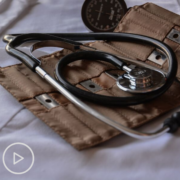AML expert, Dr. Jessica Altman, discusses common myths surrounding available AML treatment options, stem cell transplant and how leukemias are classified.
Dr. Jessica Altman is Director of the Acute Leukemia Program at Robert H. Lurie Comprehensive Cancer Center of Northwestern University. More about Dr. Altman here.
See More From The Fact or Fiction? AML Series
Related Resources
Transcript:
Patricia:
Dr. Altman, let’s talk about some AML treatment myths floating around. I’ll throw some stuff out there, you let me know if you’ve heard this. “Leukemia is one disease.”
Dr. Altman:
So, I have heard that. Leukemia is actually a number of different diseases, and it’s very heterogenous. There are acute and chronic leukemias. The acute versus chronic really depends on a couple of factors. The biologic factor is the presence or absence of 20% loss or more in the bone marrow, but that also coincides with how patients present clinically. Acute leukemias tend to present more acutely, more rapidly. And chronic leukemias tend to be a bit more indirect. And the treatments are very different for those entities.
There are also myeloid or lymphoid leukemias, so there’s Chronic Myeloid Leukemia and Acute Myeloid Leukemia and Chronic Lymphocytic Leukemia and Acute Lymphoblastic Leukemia. So, those are the four major categories. We’re talking about Acute Myeloid Leukemia today. Within Acute Myeloid Leukemia, there are multiple different types of Acute Myeloid Leukemia that are really now best categorized by history – patient history – and the molecular and cytogenetic abnormalities of the disease.
Patricia:
Now, we’ve already learned about a bunch of them. So, “There are limited treatment options” is definitely a myth. Correct, Dr. Altman?
Dr. Altman:
So, we have had a major growth of the number of treatment options available for Acute Myeloid Leukemia really in the last couple of years. It’s been a very exciting time for practitioners and for our patients that we have now a number of new therapies. So, there is not just one treatment available. In fact, the conversation regarding treatment options becomes quite extensive with patients and their families, because there are choices. And that’s why consideration of goals in the intent of treatment becomes even more important.
Patricia:
Here’s another one: “Stem cell transplant – the only chance for cure.”
| |
Stem Cell Transplant, also called a bone marrow transplant, is a procedure in which healthy blood stem cells are used to replace damaged or diseased bone marrow. This procedure can be used to treat certain types of blood cancers. |
Dr. Altman:
Okay. So, that is also a myth. There are certain types of Acute Myeloid Leukemia where stem cell transplant is the most appropriate treatment once the disease is in remission if the goal of the patient is of curative intent. Stem cell transplant is not appropriate for every individual, and for some types of Acute Myeloid Leukemia, stem cell transplant is not considered.
Patricia:
What kinds of things do you think about when you’re considering a stem cell transplant with a patient?
Dr. Altman:
So, again, I go back to patient goals and understanding their goals of treatment. A stem cell transplant is among the most medically intensive procedures that we have. It is also not just a treatment that occurs over a short time. While the actual transplant is a relatively limited hospitalization and the administration and infusion of stem cells and preparative chemotherapy, it is something that can continue to have side effects and alterations in life quality that can persist for months to years afterwards.
So, that’s one aspect of things that we talk about regarding stem cell transplant. And really understanding what the benefit of transplant is in terms of a survival advantage, versus what the risk and the cost in terms of toxicities are. And that’s the basis of a lot of the conversations we have.
Patricia:
Sure. Here’s one more: “AML patients require immediate treatment.”
Dr. Altman:
Sometimes AML patients require immediate treatment, and sometimes they don’t. And that depends on the biology of the disease. How high is the white blood count when the patient comes in? What are the best of the blood counts? Is the patient having immediate life-threatening complications of their acute leukemia?
And there’s some forms of acute leukemia that require immediate therapy to prevent complications, and there’s some forms of acute leukemia who present an extreme distress from their disease, but there are many patients who present with acute leukemia, and we have time to get all of the ancillary studies back – the studies of genetics and the molecular studies1 – to help further refine the conversation, and further design an appropriate treatment strategy.
Patricia:
What else? What do you hear from your patients that you feel is maybe a misconception or something they’re not quite understanding about the AML?
Dr. Altman:
So, I think one of the biggest things that I would like to mention is that response rate and cure are not the same. So, it is possible for one to be treated for Acute Myeloid Leukemia and the disease to enter remission, and yet still not be cured of their disease.
Acute Myeloid Leukemia is a disease that frequently requires additional cycles of treatment or a stem cell transplant after the initial induction therapy to be able to have the best chance for a long-term cure. So, response and cure are not the same thing.













